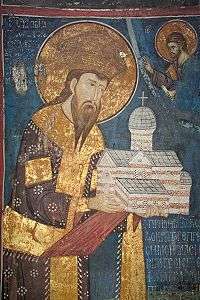Ktetor

Fresco of Stefan Dečanski at Dečani monastery holding a small monastery in his hands; this signifies that he is the ktitor of the monastery.
Ktetor (Greek: κτήτωρ) or ktitor (Cyrillic: ктитор; Georgian: ქტიტორი; Romanian: ctitor), meaning "founder", was a title given in the Middle Ages to the provider of funds for construction or reconstruction of an Orthodox church or monastery, for the addition of icons, frescos, and other works of art. It was used in the Byzantine sphere. A Catholic equivalent of the term is a donator. As part of founding the ktetor often issued typika, and was illustrated on frescoes ("ktetor portrait"). The female form is ktetorissa (Greek: κτητόρισσα) or ktitoritsa (Cyrillic: ктиторица).
Sources
- Thomas, John P. (1987). Private Religious Foundations in the Byzantine Empire. Washington, D.C.: Dumbarton Oaks.
- Geoffrey Wainwright (2006). The Oxford History of Christian Worship. Oxford University Press, USA. pp. 287–. ISBN 978-0-19-513886-3.
| Wikimedia Commons has media related to Ktitor. |
This article is issued from
Wikipedia.
The text is licensed under Creative Commons - Attribution - Sharealike.
Additional terms may apply for the media files.